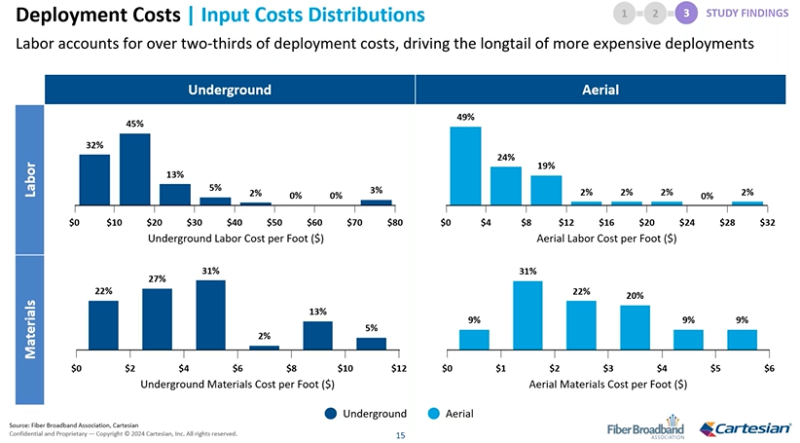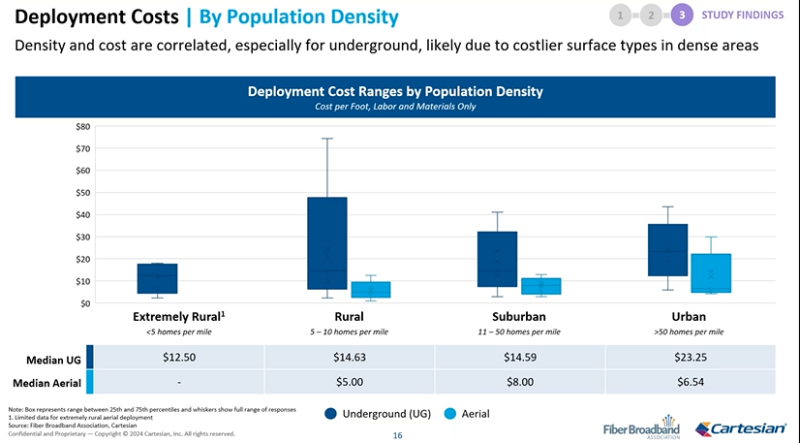The Fiber Broadband Association (FBA) partnered with consulting firm Cartesian to determine what exactly goes into fiber deployment costs and how those costs are evolving over time.
One key takeaway is it’s typically more expensive to build fiber underground than deploy aerial fiber. According to a report FBA and Cartesian put together, the median cost for underground deployments is $16.25 per foot, more than twice the median cost of aerial deployments ($6.49 per foot).
Cartesian conducted a study on FBA’s behalf, receiving input from providers and contractors across 35 states. Most respondents (70%) said they use a combination of underground and aerial construction methods, while 25% reported they only use underground deployments and just 5% said they exclusively use aerial fiber deployments.
“There’s many reasons why an entity’s going to choose underground over aerial, such as being in an area with adverse weather conditions that will more frequently threaten above-ground infrastructure,” said Meg Corriveau, consultant of strategy and analytics at Cartesian, at an FBA webinar this week.

The option to dig is also almost always available, the report noted, whereas aerial construction is impacted by factors like access to poles and the risk of cable breaks.
“Labor is the main chunk of the cost” for both aerial and underground deployments, Corriveau continued. Respondents said labor made up around 73% of the cost of underground deployments and 67% of aerial construction costs. Labor’s share of cost was roughly twice that of construction materials.
“Given labor’s obvious outside share here in the role that it plays in the cost of deployment, it makes sense for providers to seek efficiencies here through labor’s cost,” she said.
Population density
Deployment costs are likely to be more expensive in densely populated areas, Cartesian found, both for underground and aerial methods.
However, underground deployments are still a more costly option in this case. The median underground deployment cost in urban areas (with more than 50 homes per mile) is $23.25 per foot, whereas the median aerial cost is $6.54 per foot.

“This makes sense – underground construction involves digging up and restoring the surface, which is a bit more involved in more densely populated areas,” said Corriveau. “We have roadways, sidewalks and other utilities competing for the same space.”
Construction technique
Cartesian found trenching was the cheapest construction method for underground deployments, with a median cost of $12 per foot. Plowing was the most expensive at $17 per foot.
Directional boring was the most frequent method respondents cited ($15.10 per foot median cost), but “it had the widest range of reported costs,” Corriveau explained, “oftentimes surpassing all other methods.”
Other construction options the survey mentioned were micro-trenching as well as a combination of methods.
“Method is really a product in and of itself of what options are available, based on the terrain and a lot of other factors,” she said.
For example, providers said rocky terrain was the most expensive environment for deploying fiber ($20 per foot). Soft earth was the cheapest at $10 per foot.
Corriveau said terrain is a key factor for determining deployment costs in certain areas. But it’s further complicated when some geographies have, for instance, “a water formation next to a mountain” or other diverse elements,
“It’s not a one-size-fits-all…what’s normal for one area is going to vastly differ in a different area due to the terrain you have to work with,” she said.